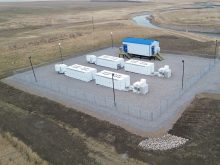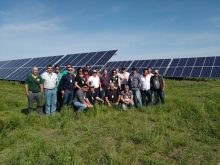A pilot project that repurposes defunct oil and gas well sites into small solar arrays is up and running near Taber, Alta., but the founder of the company doing the work says red tape is preventing expansion of the initiative.
Keith Hirsche, president of RenuWell Energy, said two projects in Barnwell and Fincastle are performing as expected and are helping offset electrical costs associated with running irrigation pivots. The projects also offset costs associated with well site remediation.
The system is designed to match peak summer production of solar energy with peak demand for irrigation use.
Read Also

Canola oil transloading facility opens
DP World just opened its new canola oil transload facility at the Port of Vancouver. It can ship one million tonnes of the commodity per year.
“The power that our projects generate stays in the same local grid as the loads in that grid,” said Hirsche of the two one-megawatt projects owned by Irrigation Canal Power Co-op.
The project ticks many boxes, including oil well site reclamation, municipal tax generation and surface lease payments to landowners, while providing low-cost, low-emission power.
But regulatory changes are required before more projects can proceed.
Hirsche said 80 irrigators use solar microgeneration in the Municipal District of Taber. It differs from small-scale generation because it involves individuals rather than community groups, but in either case, less infrastructure is required. He said that’s preferable to building large, utility-grade systems that require transmission lines. Power produced locally could be used locally.
Regulations for microgeneration have been developed to accommodate thousands of projects in the province, but that isn’t the case for small-scale solar systems.
“They never completed the rules,” said Hirsche of small-scale generation. “There have been only three community generation projects of the small size built under five megawatts, and we’re two of them.”
He said most of the resistance has come from large transmission providers and, since the rules surrounding small-scale generation are incomplete, there is no appeal mechanism to override such roadblocks.
RenuWell has been working with the provincial Orphan Well Association, M.D. of Taber and landowners to build a network of about 40 other sites, but Hirsche said the current rules make it difficult.
“It’s death by a thousand cuts,” he said, describing the regulatory framework. “We drafted a resolution for the RMA (Rural Municipalities of Alberta) together with the M.D. of Taber.”
That resolution, presented during last year’s fall RMA meeting, stated that if Alberta wishes to see adoption of small-scale solar generation, “and repurposing of inactive oil and gas leases to solar generation, there must be additional consideration for ease of connection to the distribution and transmission grids.”
The resolution passed with 75 percent of voting members in favour.
Hirsche said small-scale solar projects can also address concerns about industrial-scale renewable projects that remove productive agricultural land. Smaller arrays can be placed in former well site areas and in the pivot corners of irrigated land.
“If we can get 50 percent of the inactive leases in the M.D. of Taber, we can generate as much power as the Travers Solar Project and we won’t be taking anything from agriculture,” he said.
The Travers Solar project straddles more than 3,000 acres of land in Vulcan County and has a 465-megawatt generation capacity.


















